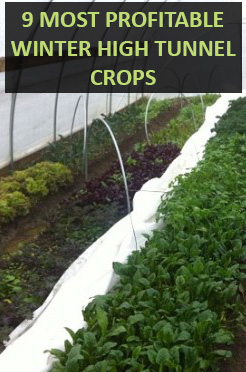9 of the Best Winter Crops to Grow in a High Tunnel | Profitable Farming
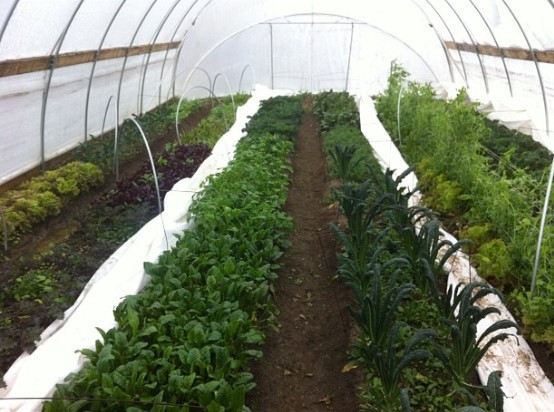
If you are looking to grow crops during the colder parts of the year you will have more success growing plants that like the cold. This is a good rule of thumb when growing in the field, and it holds true when growing in a High Tunnel. In this post, we put together a list of 9 of the best crops to grow in a high tunnel hoop house during the winter.
1. Kale
If we are talking about plants that like the cold (and we are), kale is a perfect example. Multiple varieties of kale have demonstrated they do amazingly in unheated high tunnel environments. While the kale plants can handle cold temperatures even below freezing sometimes, a high tunnel provides just enough protection to allow them to mature faster, get larger, and provide a number of winter harvests.
Kale Has a Fast Rate of Growth in High Tunnel Plantings
According to a study at the University of Tennessee called Cool Season Specialty Crops in High Tunnels, Kale planted in a high tunnel will grow much faster than late season kale planted in the field or in low tunnels on the same dates. In other words, the protection of a high tunnel is very beneficial to the growth of kale even though it is a plant well suited to late season fall temperatures.
This jump in growth is very important to get the plant to a mature state before day length decreases in the coldest parts of winter.
Kale Has a Good Return per Plant
We know kale likes the cold, but it also has a relatively high return on investment. According to one farms' results and presented in a University of Vermont power point, a 28 ft. row of green curly kale planted in a high tunnel with three lines of kale planted per row, provided $1,134.00 of revenue for that row of kale. For that particular case study that added up to a net sale number of $16.20 per kale plant in that row (Source: Page 69 of University of Vermont Power Point).
2. Spinach
Spinach is possibly the most popular high tunnel crop out there. This is primarily due to the fact that spinach is acclimated to cold weather, but also because spinach can be densely planted, and sold for a relatively high dollar amount per lb. Because spinach can be planted densely it provides the opportunity to make a good amount of money per square ft. / per row.
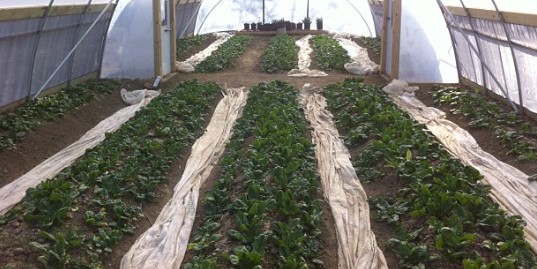
Spinach Can Be Densely Planted
Spinach can be planted densely, as close as 6 inches between plants in all directions if you are looking to plant as many as you can. To give you an idea of how densely spinach can be planted in your high tunnel, you could fit 240 plants in a 28 ft. long bed.
RELATED: 5 Ways to Insulate Your Greenhouse or High Tunnel and Protect Crops
This compares to just 70 Kale plants that could fit in the same amount of space. This goes to show that a lot of spinach can fit in a small amount of growing space.
Spinach Can Provide Solid Cash Flow
Not only is spinach a crop that can grow in high density, but it also has a good return per square foot. According to a University of Vermont case study, a 28 ft. long bed of spinach, where 4 to 5 rows of spinach are planted per bed, the total revenue generated was $1,280.00. Not bad for 28 ft. of bed space, and definitely not bad for winter sales (Source: Page 69 of University of Vermont Power Point).
3. Salad Mix
Salad Mix is a great winter high tunnel crop to plant because it is a cut-and-come-again crop. Additionally salad mix is able to be very densely planted. While not being able to drop to the same extreme low temperatures as Kale and Spinach, Salad Mix can handle pretty extreme cold temperatures as long as the high tunnel has heavy frost blanket included inside in order to cover the salad mix before the coldest nights.
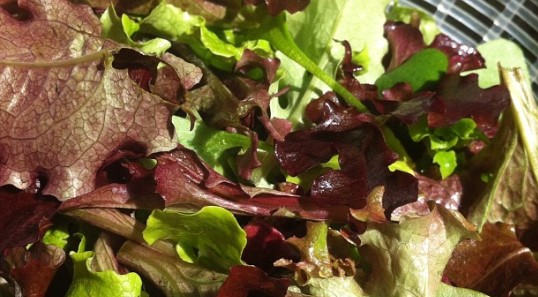
There are various salad mix options on the market, but the salad mix I enjoyed growing in my high tunnel was Johnnys Selected Seeds Allstar Salad Mix. The benefit of this salad mix is that it seemed to be highly marketable, and was harvest-able through the month of December (we were Zone 6b) for our CSA program.
RELATED: Best Backyard Greenhouses | High Tunnels for Backyards
There are other salad mix options out there, some of which may have lower seed prices than the one I reference above, but the point remains that salad mix provides a great leafy green option for the winter high tunnel months. A 28 ft. long bed planted in a high tunnel with 14 to 15 rows of densely planted salad mix can provide $1,200 revenue (Source: Page 69 of University of Vermont Power Point).
One such salad mix that provides a different mixture of greens is a spicy braising mix, which has a variety of mustards and asian greens that are intended to be densely planted and harvested young. Below is a picture of this type of salad mix.
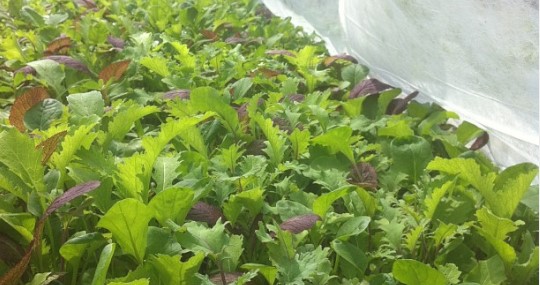
Take note of how densely the above braising mix is planted. This is one of the benefits of planting a salad mix in a high tunnel bed, as the dense plantings can prevent weeds from growing.
4. Boc Choi / Pac Choi
Boc Choi is a relatively common vegetable, but is also a unique item to offer for sale in the month of December and January. If I had to describe Boc Choi I would describe it as surprisingly resilient to freezing temperatures, as I have witness the leaves completely freeze only to bounce right back.
RELATED: Best Greenhouse Plastic | Comparing Through First Hand Experience
The downside of growing Boc Choi in the winter months is your growing space is limited in a high tunnel and the spacing between the Boc Choi is more than some of the other crop options you have. Spinach, Salad Mix, and Root Crops can all be planted closer together in a dense high tunnel bed. For this reason, Boc Choi should be considered a good high tunnel crop to grow as a part of a CSA or to fill out a farm stand, but it may not make the most sense to grow as a singular item to get the fastest pay-off per square ft.
5. Carrots
Carrots are a fantastic crop to grow in a winter high tunnel. Carrots are well suited to handle the cold temperatures of winter, and in a protected environment where constant cold wind isn't an issue, they can thrive. Carrots take longer to mature than some of the other crops listed in this post, but if you plant them early enough in your high tunnel you will be able to harvest them throughout the entire winter.
Here are three reasons we love growing carrots in a high tunnel:
1. Carrots can be planted very densely for maximum harvest potential
2. Carrots are a relatively heavy crop that adds heft to a CSA bag
3. Carrots grown in a high tunnel are typically sweeter due to the sugars released in the cold.
Carrots are also a wildly popular crop in most markets, and as far as winter harvests are concerned it makes sense having carrots to sell during soup season. The market for carrots exists in the colder months and growing them in your high tunnel is a great way to reap the rewards they have to offer.
6. Beets
Beets have experienced a renaissance over the last decade as small growers and artisan restaurants began embracing how delicious they are. The reasons you may want to grow beets in your high tunnel are very similar to the reasons you may want to grow carrots in your high tunnel.
Beets are extremely resilient to cold temperatures, and can even sustain some temperature drops below freezing. Beets are a hefty crop though, and they can provide a large number of harvest weight per square foot of bed space.
RELATED: 4 Ways to Attach Greenhouse Plastic to a Metal Frame
Beets can be planted very closely together, take less time to mature when compared to carrots, and provide a heavy vegetable crop for any CSA share.
7. Radish
Radishes are pretty much a universal staple crop when it comes to salads. The fact that the radish is such a beloved member of almost all salads means that there will be a market and a desire for radishes. They also happen to handle cold temperatures extremely well. Another main reason to consider planting radish in your high tunnel is its extremely fast maturation rate.
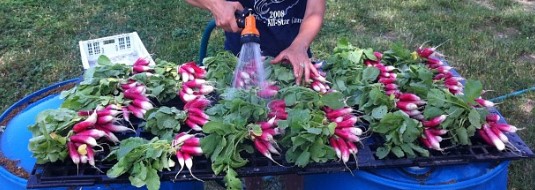
Radishes can grow to maturity much faster than other cold loving crops you may be planning to harvest through the winter. For this reason, radishes are often seen as one of the first crops to get harvested out of your structure, while they may be the last crop planted in your high tunnel. Planting them in your high tunnel last in preparation for winter harvests would make a lot of sense since they mature much faster than the other crops; this can be true even when the decreasing day length is taken into consideration.
8. Turnips
Hakurai Turnips are a specific turnip variety that winter growers look to for quality winter production. They do well in cold weather, and can handle freezes when accompanied with a layer of heavy frost blanket. That said, turnips are a crop that may best be used as a supplement to other high tunnel crops since there tends to be less demand for turnips, and they don't often yield the same dollar amount per square ft. as some of the other crops we reference in this post.
9. Mizuna
Mizuna is similar to the Salad Mix we reference earlier in this post. That is to say, Mizuna can be planted very densely, and it is a cut and come again crop. On its own it is a delicious green, and when mixed in with other salad mixes it provides a healthy leaf that would
Cooler air temperatures will slow the maturity of leafy greens when temperatures in the high tunnel dip below 40 degrees, however, Mizuna can handle freezes and tends to bounce back. using a heavy frost blanket with Mizuna will provide night time protection from dips in temperature (Source: Pennsylvania State University Department of Horticulture).
Mizuna is similar in plant spacing to the Salad Mix referenced earlier in this post, as you can plant it very densely with many rows per bed. This helps drown out weed pressure, and also provides for bountiful harvests. Like spinach and salad mix, Mizuna is a cut-and-come-again crop which can provide multiple harvests.
Most important to note about Mizuna is it is delicious in a salad.
Selecting the Right Crops to Grow in Your Winter High Tunnel
If you're reading through the list above and trying to narrow down which of the crops to plant in your high tunnel for the winter you should consider the purpose of your high tunnel first. If you are looking to grow food for you and your family, and not for sale, you should focus on which of the crops you and your family would appreciate the most in the middle of the cold months.
For those planning to produce as much as they can in their high tunnel for sale it would make sense to tailor the space inside the high tunnel to produce the crops you need for your business model. If you sell wholesale, you will want to plant fewer varieties of crops and more of them. If you operate a CSA you may want to plant enough variety where the harvest dates are spread through a number of weeks.
RELATED POSTS:
- 10 Crucial Hardware Components for High Tunnel Build
- Best Greenhouse Plastic for High Tunnel Build
- Best Shade Cloth for Tomato High Tunnel Production
- Greenhouse Roll-up Sides - How To Configure
- 5 Ways to Insulate a Greenhouse High Tunnel
- 4 Ways to Attach Greenhouse Plastic to Metal Framing
